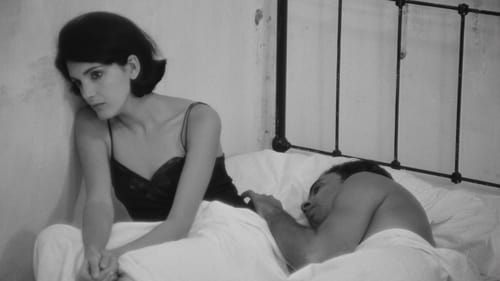
Interviewee
A look at the life and work of Cuban filmmaker Tomas Gutierrez Alea.

Editor

Editor
A handsome and mysterious stranger, played by Darío Grandinetti, walks into the town square of Villaserena one day and strategically places loudspeakers around the town, blaring a variety of musical tunes. Soon, he begins to sell airtime to the various locals, who broadcast their own personal love dedications and (more frequently) insults for all to hear. A subplot evolves between Abelardo (the stranger), Celeste (a young woman who is chained inside her father's house to stop her running away), and José (a young man).

Editor
The action is situated in Colombia on April 9, 1948, date in which took place the famous "Bogotazo". It is a story of love frustrated by political circumstances. Laura, a spinster schoolteacher, lives to Josefina and Santiago, public employee. The three characters will be besieged by 24 hours, targeted by snipers, will be forced to show such which are or they would have liked to be.

Editor
A telephone operator from Mexico City tries to support a family and her passion for popular dance.

Editor

Editor
The world of a young psychiatrist is shattered when she finds out that her husband is having an affair with one of her patients.

Editor
In 1914, during World Ward I, Amada, a bourgeois wife, falls in love with her cousin Marcial, a young idealist who is fighting against the Cuban regime in power.

Screenplay
In 1914, during World Ward I, Amada, a bourgeois wife, falls in love with her cousin Marcial, a young idealist who is fighting against the Cuban regime in power.

Director
In 1914, during World Ward I, Amada, a bourgeois wife, falls in love with her cousin Marcial, a young idealist who is fighting against the Cuban regime in power.

Writer
The story of Cecilia is a story of the society that dominated 19th-century Cuba, a society divided between whites, blacks, and those who were mixed, the mulattos. (Since the Spanish conquistadors killed off the Indian population in Cuba not long after they took over the island, there are no mestizos, or those of mixed-Indian blood in Cuba as in other Caribbean nations.) At any rate, the drama about the life and loves of Cecilia (Daisy Granados) takes place against the backdrop of graphically violent mistreatment of slaves and the rumors of a slave rebellion after the Cubans hear of slaves turning against their captors in Haiti.

Editor
Mexican drama film directed by Miguel Littín. It is based on a short story of the same name by Gabriel García Marquez. It was entered into the 30th Berlin International Film Festival

Editor
A bourgeois Cuban family of aristocratic origin locks itself into its mansion when the Cuban Revolution comes to power, waiting for the new regime to be overthrown. As time passes, they regress to older and older systems of policital order, from capitalism to feudalism to "primitive savagery."

Editor
Based on the events leading to the Spanish-America War of 1898. It reflects on the expansionist policies of the United States since its inception. A historical chronology that shows the consequences for Puerto Rico of the imperialist war against Spain: colonization and relentless attempts to annex it to the States.

Editor
The story of the Santa María School massacre of miners in 1907.

Editor
A pious plantation owner attempts to teach Christianity to 12 of his slaves by inviting them to participate in a reenactment of the Last Supper.

Writer
It is the story of a young man named Esteban, who was totally devoted to the cause of the Revolution against Fulgencio Batista. One day, Esteban is diagnosed with a cerebral aneurism, which causes him to take stock of his life as a revolutionary and to reconsider his relationships to his family--to his mother and brother, particularly--and his friends.

Editor
Based on the novel Francisco by Anselmo Suárez y Romero, "The Other Francisco" is a socio-economic analysis of slavery and class struggle through the retelling of the original novel. The film contrasts the romantic conceptions of plantation life found in Suárez Romero's novel with a realistic expose of the actual historical conditions of slavery throughout the Americas. It offers a critical analysis of the novel, showing how the author's social background led to his use of particular dramatic structures to convey his liberal, humanitarian viewpoint.

Writer
Rebuild, in the same place of events, a trial held in 1969 to four men, accused of sabotage for having caused the fire of a forest plan that caused the death of eight people and large material losses. At the same time, it analyzes retrospectively the circumstances that contributed to the occurrence of the crime.

Editor
During the socialist government of Marmaduke Grove in 1932, a group of villagers decide to take some land in the area of Palmilla. Almost like a mythical journey, problems arise when seated and in a position to bring the socialist ideal in the population. Everything becomes more complicated with rumors that the reactionary forces have overthrown the socialist government. A movie that because of the coup was not released in Chile and was only terminated by Littin in exile in Mexico.

Editor
In 1672 Cuban revolutionaries launch an uprising against the Spanish who are occupying the country.

Editor
A psychedelic combination of Shakespeare, rock & roll and Catholic symbolism in the shape of a Cuban ballet.

Editor
루시아는 각각 다른 시대적 상황을 배경으로 여성해방의 문제를 그린 3부작 옴니버스 영화로, 주인공들의 이름이 모두 루시아다. 1부에서 라파엘을 죽인 루시아는 끌려가던 거리에서 “쿠바는 깨어나라”고 외치는 한 미친 여자에게서 위로를 받고, 2부에서 독재자 바티스타 정권에 넘어간 암울한 극적 분위기를 마무리하는 것은 카메라를 쳐다보는 루시아의 눈이며, 3부에서 혁명군에게 글을 배운 문맹의 루시아가 처음으로 쓴 문장은 “난 떠나요. 난 노예가 아니에요”다. 이렇듯 혁명 이전과 이후 해방의 분위기 속에서도 해방된 삶을 살고 있는 건지 의심스러운 여러 루시아들의 삶을 극적으로 그려내고 있다. 토마스 구티에레즈 알레아 감독과 더불어 현대 쿠바영화의 거장인 움베르토 솔라스 감독은 각 이야기의 시대와 주제에 따라 영화의 스타일을 달리했다. 1890년대의 이야기는 멜로드라마로, 1930년대에는 복고풍의 화면으로, 마지막 1960년대의 이야기는 가벼운 코미디로 그려냈다. 2시간 40분이라는 만만치 않은 상영시간 동안 그는 파노라마처럼 시대의 변화를 담아낸다. 그것을 결국 역사의 흐름이 ‘진보’쪽에 있었음을 능숙하게 설득시킨다. 1960년대 말의 쿠바영화가 고전기 할리우드 혹은 구소련 영화와 맞먹는 형식미를 보여주는 걸작이다.

Writer
루시아는 각각 다른 시대적 상황을 배경으로 여성해방의 문제를 그린 3부작 옴니버스 영화로, 주인공들의 이름이 모두 루시아다. 1부에서 라파엘을 죽인 루시아는 끌려가던 거리에서 “쿠바는 깨어나라”고 외치는 한 미친 여자에게서 위로를 받고, 2부에서 독재자 바티스타 정권에 넘어간 암울한 극적 분위기를 마무리하는 것은 카메라를 쳐다보는 루시아의 눈이며, 3부에서 혁명군에게 글을 배운 문맹의 루시아가 처음으로 쓴 문장은 “난 떠나요. 난 노예가 아니에요”다. 이렇듯 혁명 이전과 이후 해방의 분위기 속에서도 해방된 삶을 살고 있는 건지 의심스러운 여러 루시아들의 삶을 극적으로 그려내고 있다. 토마스 구티에레즈 알레아 감독과 더불어 현대 쿠바영화의 거장인 움베르토 솔라스 감독은 각 이야기의 시대와 주제에 따라 영화의 스타일을 달리했다. 1890년대의 이야기는 멜로드라마로, 1930년대에는 복고풍의 화면으로, 마지막 1960년대의 이야기는 가벼운 코미디로 그려냈다. 2시간 40분이라는 만만치 않은 상영시간 동안 그는 파노라마처럼 시대의 변화를 담아낸다. 그것을 결국 역사의 흐름이 ‘진보’쪽에 있었음을 능숙하게 설득시킨다. 1960년대 말의 쿠바영화가 고전기 할리우드 혹은 구소련 영화와 맞먹는 형식미를 보여주는 걸작이다.

루시아는 각각 다른 시대적 상황을 배경으로 여성해방의 문제를 그린 3부작 옴니버스 영화로, 주인공들의 이름이 모두 루시아다. 1부에서 라파엘을 죽인 루시아는 끌려가던 거리에서 “쿠바는 깨어나라”고 외치는 한 미친 여자에게서 위로를 받고, 2부에서 독재자 바티스타 정권에 넘어간 암울한 극적 분위기를 마무리하는 것은 카메라를 쳐다보는 루시아의 눈이며, 3부에서 혁명군에게 글을 배운 문맹의 루시아가 처음으로 쓴 문장은 “난 떠나요. 난 노예가 아니에요”다. 이렇듯 혁명 이전과 이후 해방의 분위기 속에서도 해방된 삶을 살고 있는 건지 의심스러운 여러 루시아들의 삶을 극적으로 그려내고 있다. 토마스 구티에레즈 알레아 감독과 더불어 현대 쿠바영화의 거장인 움베르토 솔라스 감독은 각 이야기의 시대와 주제에 따라 영화의 스타일을 달리했다. 1890년대의 이야기는 멜로드라마로, 1930년대에는 복고풍의 화면으로, 마지막 1960년대의 이야기는 가벼운 코미디로 그려냈다. 2시간 40분이라는 만만치 않은 상영시간 동안 그는 파노라마처럼 시대의 변화를 담아낸다. 그것을 결국 역사의 흐름이 ‘진보’쪽에 있었음을 능숙하게 설득시킨다. 1960년대 말의 쿠바영화가 고전기 할리우드 혹은 구소련 영화와 맞먹는 형식미를 보여주는 걸작이다.

Editor
젊은 부르주아 세르지오의 이야기. 혁명이 몰아 닥치고 가족들이 쿠바를 떠나는 상황에서 그는 쿠바 안에 남기로 결심한다. 혼자가 된 세르지오는 삶의 이유를 찾기 위해 자신의 어린 시절, 가족, 연인 그리고 불행들과 같은 과거를 기록하기 시작한다. 혁명은 점점 그에게 도전으로 다가선다. 모든 것은 '10월 위기'동안에 끝나버린다. 세르지오는 그가 받은 모든 교육과 가치가 산산이 부서지는 것을 발견하는데...




















